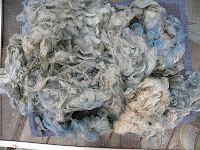I have been in a whirlwind for the better part of a couple of weeks. Woodstock's (i.e. Ontario, Canada) Fleece Festival took place on Oct. 23/10 with both my husband and friend participating and sharing a booth.
My husband was selling his fine wooden tools for spinning and weaving while my friend was selling her alpaca and shetland fleece and prepared fibre. Both had a wonderful day selling to the fibre loving community, which I must note is growing. It was a wonderful experience to be involved.
The very next day was the start of level 2 in the Master Spinner program from Olds College, Alberta. Once again we had the pleasure and good fortune of being taught by Rosemary Harris, whom had already taken us through level 1 in spring of 2010.
This level we are blending fibres - wool (that being specifically from sheep) with mohair, llama, alpaca, and the different silks. I will from here on be extremely busy with my homework so I can be ready for level 3 in the spring. (If life doesn't throw me any big surprise that is!)
I have fleece to card, comb, blend and spin. Also there are books to read and report on; research on stories involving spinning and songs that are spinning related. This can also include personal stories passed down in families.
So.... if you have any family stories involving spinning fibre, be a dear and email me with them.
Here are a couple of pictures from class:
 |
| A beautiful sunrise to start the day on Wed. Oct. 27/10 |
 |
| My Classmates Level 2 |
 |
| A close look at Kanef fibres on a field trip . |
A look at Kaneff plants growing at a farm show site. They are the tall thinskinny stalks, some still with lovely flowers at this late October date.
 |
| Kanef stalks |
 |
| Nostepinne for winding balls of spun wool |
 |
| Pat Green carder |
 |
| Ashford carder |
 |
| Sunset - Thurs. Oct. 27/10 |
I've been spending the last couple of days scouring wool; one day woad dyeing; and managing to fit in a little sewing. More on the other fibres later. I've some spinning of Cormo to do now.




















































